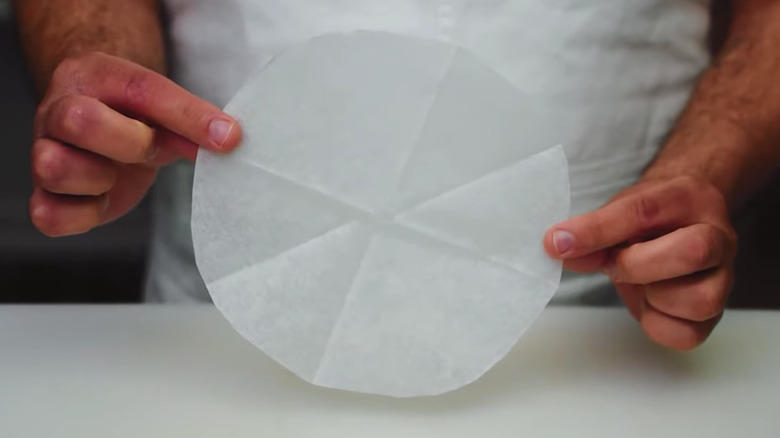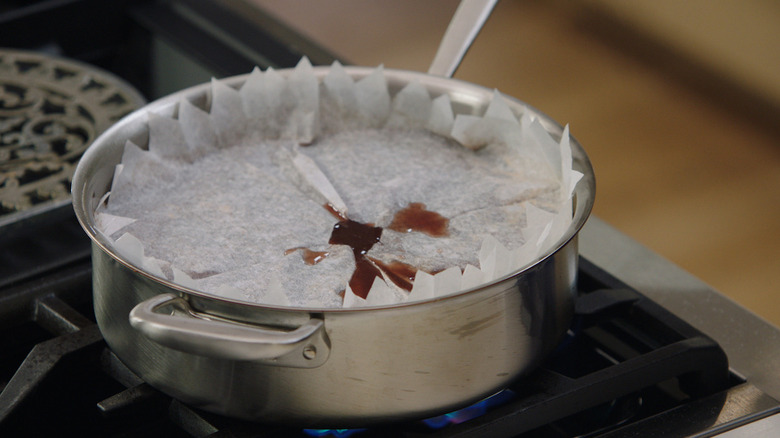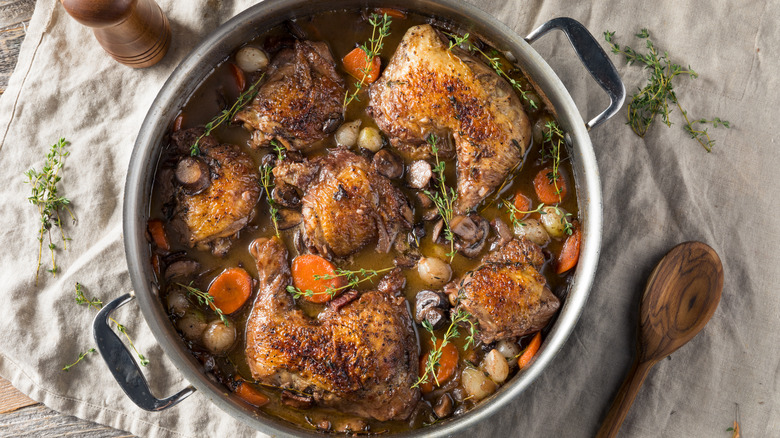Upgrade Your Poaching Experience With The Help Of Parchment Paper
Knowing the gentle bubbling temperatures of poaching is an essential tip for your cooking arsenal, be it for eggs in the morning or some boozy fruit for dessert. Parchment — or baking — paper is the unexpected route to upgrading your poaching game, all thanks to employing a classic French cooking trick: the cartouche.
You might think that your pan's regular lid is just fine for keeping liquid covered, but the parchment paper cartouche is better for poaching purposes, thanks to a little bit of culinary science. Even though poaching liquid — whether plain water, stock, or syrup — isn't boiling, it still evaporates during the cooking process.
Keeping the liquid covered is essential because the main ingredient can dry out or burn if it evaporates too much. But because the pan's lid is made of metal, it conducts some of the heat emitted from that evaporation and condenses the evaporating liquid back into the pot. If you've ever taken the lid off a braise or poach and had clear water drip onto the stove, this is why. Trying to solve this by leaving the lid partly covering the pan creates uneven evaporation and does nothing about the condensation. A cartouche solves both of these problems, allowing steam to escape evenly without the condensation effect, as well as directly submerging the poached ingredient for maximum contact with the liquid.
How to make a cartouche
This "lid" for a pot is the nifty route to better control your poaching recipes, and all it takes is a few minutes and a reel of parchment paper. Making the cartouche requires measuring your paper to fit your pan and using a clever cutting method to turn it into a snug, perfectly circular cover. You can even add a little vent in the middle to allow steam to escape.
Once you know how to make a cartouche, you can use it to keep your ingredients fully submerged in their poaching liquid, without having to fill your pot to the brim. With that condensation from the lid no longer dripping into your pan, your braises and poached foods — already a slow cooking process — won't be slowed down further, and there's no risk of any food bobbing out of the liquid and drying out.
Why the cartouche isn't just for poaching
A cartouche's properties also make it perfect for another slow-cooking method: braising. Keeping a lid on a pot doesn't just risk boiling or condensation; it also inhibits the dark, caramelized flavor from the Maillard reaction essential to a coq au vin or short rib braise. This is because steam cannot escape at all, and if you were to remove the lid entirely, the braise would simply boil dry.
The parchment paper lid of a cartouche again offers the best of both worlds. Its vent and proximity to the surface of the liquid allow some steam to escape for flavor concentration and browning while retaining most of the moisture that keeps a braise tender, with plenty of delicious sauce and, crucially, no skin on top if it's left to cool.
And, the eagle-eyed cooks amongst you may have noticed that the cartouche has another handy culinary application, which has nothing to do with liquid. Apply the same technique for making one to your favorite round baking tin or loaf pan, and you'll find a foolproof method for lining your cake tins accurately every time.


